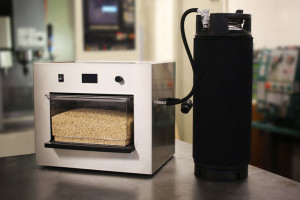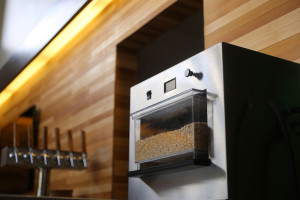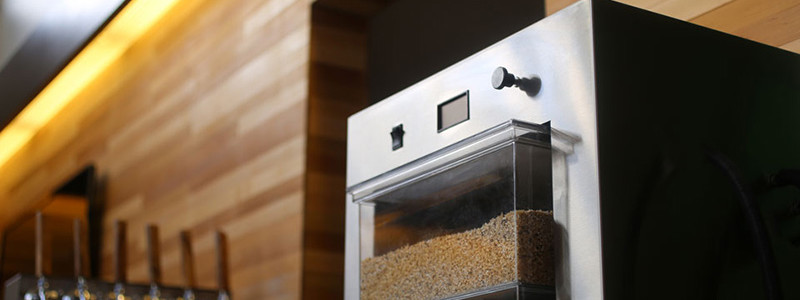A Cool (and Hot) Appliance
 The Picobrew Zymatic is a device for making beer it home. It sprang onto the scene in 2013 as the first “beer-making appliance.” It has been compared to a bread machine since it controls the brewing process for you after you add the ingredients and select the recipe you want it to make.
The Picobrew Zymatic is a device for making beer it home. It sprang onto the scene in 2013 as the first “beer-making appliance.” It has been compared to a bread machine since it controls the brewing process for you after you add the ingredients and select the recipe you want it to make.
Once everything is set up, the Zymatic goes through the steps programmed into your selected recipe. This means you, as a brewer, do not have to handle hot hoses, risk getting splashed with scalding water or worry about forgetting a hop addition.
After telling the device to start brewing, the brewing process takes about four hours. This includes mashing the grain for starch conversion to fermentable sugars to make wort, isomerization of alpha acids into bitterness, and adding hops for flavor and aroma.
Once the brewing process is done, all you have to do is cool the wort, add (pitch) your yeast, wait for fermentation to complete, and carbonate the beer as normal.
I Can Make Beer in Four Hours?!
Unfortunately, no. You can’t make beer in four hours. This device technically makes wort, not beer. Just like with un-automated homebrewing, you have to ferment the wort in order to produce beer. The fermentation process takes anywhere from five days to several weeks, depending on the strength of the beer, type of yeast and temperature at which the beer is fermented.
Is Fermentation Really Needed?
Fermentation is the process that produces alcohol from the sugars in the wort. After pitching the yeast, they ferment most of the sugars dissolved in the wort to produce alcohol, yeast esters (flavors and aromas), and carbon dioxide. The fermentation process also brings the flavors into balance with each other.
Unfermented wort is extremely sweet, and drinking more than a few ounces becomes unpleasant due to that overpowering sweetness. Through fermentation, the sweetness fades as the yeast consume the sugars in solution. This makes the bitterness and flavor from the hops more pronounced, and beer more refreshing. Since not all sugars from the barley (and other grains) are fermentable, there is always some degree of sweetness left in the beer. This contributes to the body and mouthfeel of the beer, and allows the bitterness to be enjoyable to the beer drinker at the end.
What’s the Difference?
 You may wonder how the process differs from the setup many home brewers use to make beer. The main difference is that the process is controlled by a computer built into the Zymatic, rather than handled manually by a human separating the liquid from the grains and adding hops at specific times.
You may wonder how the process differs from the setup many home brewers use to make beer. The main difference is that the process is controlled by a computer built into the Zymatic, rather than handled manually by a human separating the liquid from the grains and adding hops at specific times.
This can give the brewer a greater degree of control and consistency in the beer they make, since it doesn’t matter if the brewer gets distracted in the middle of the brew. The computer monitors the whole process, freeing you up to do other things, like sample the last batch you made.
There are some technical differences in the process.
- The wort never reaches a boil, but due to the circulation process within the machine, the beer comes out tasting like it went through a full boil.
- After the process completes, the beer still has to be cooled. Many home brewers have a chiller they use to cool the wort as the final step of the brewing process. Since your wort is in a sealed keg upon completion, you have many options for cooling the wort quickly.
- Easier cleanup. Once your brew day is complete, you can clean the tray that holds the grain quickly, and there is a “cleaning cycle” programmed into the machine to make sure you do not end up contaminating your next batch.
Is the Zymatic for you?
It depends. The cost is out of reach for many people, but is reasonable for others.
Brewers who love the manual process of managing each part of the brew day will not like this device, since it automates the process(es) they love. However, if you enjoy the process of creating recipes more than brewing, this is an ideal machine since it handles many of the technical details of the brewing process. It would also be an ideal fit for someone with limited space, since it is about the size of a bread machine, and the beer can be fermented in a smaller container than the keg delivered with the unit.
If this sounds like a solution for you, the Picobrew Zymatic can be purchased at More Beer online and delivered to your house.
If you purchase through the links on this page, I will receive a small payment which allows me to continue creating content about making beer and wine at home.


